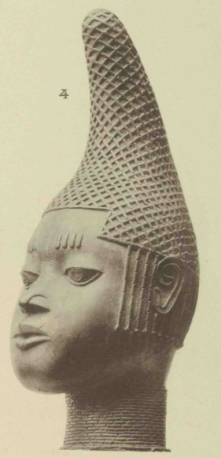Sir Ralph Moor, K.C.M.G., Her Majesty's Commissioner and Consul General for the Niger Coast Protectorate and Mr. Roupell collected the information below and forwarding this to the Foreign Office in London averred that, “The foregoing narrative has all the appearance of veracity, and as it was derived from the men among whom tradition was most likely to be preserved, we may accept it with a few minor reservations.” (Read & Dalton, 1897,Page 7).
The information was obtained at Benin city, in November, 1897, from the following chiefs :—
On Benin involvement in the Transatlantic Slave Trade Benin Chiefs had this to say:
“King Esige or Osawe was very old and could not walk about, but all the time he could tell his boys that he was a white man when he was born, and he wanted to see white man again before he died. So they sent messengers with some tusks as presents to the country by the big water where white men used to come, and they told the messenger to go and salute any white man they found there, and beg him to come; which they did. And ever since then white men have come to Benin. The white men stayed long, many many years; they came to trade, and if a man comes to trade he must sit down and sell his things softly, softly,—they used to buy ivory, redwood, oil, gum and slaves, but principally ivory—in return they brought guns, powder, rum, salt, cloth and silk. Then there was a different white man who used to come, but he only bought slaves. When he came, a messenger used to come before him to tell everyone he was coming; then if a man had any slaves to sell, he could send to farm to get them. But he only paid a poor price, 1-4 bags. These white men used to sit down at Gwatto, and there they built houses, big houses with big doors in which they kept their goods and slaves.” Page 5. [See also Disney A. R. 2009.]
Analysis
Evidence from this narrative proves beyond reasonable doubt that the concept of large scale trading in slaves was not a practice that the Benin people were used to or engaged in: “Then there was a different white man who used to come, but he only bought slaves. When he came, a messenger used to come before him to tell everyone he was coming; then if a man had any slaves to sell, he could send to farm to get them.”
The slaves sold to this one Whiteman were domestic slaves working on family farms. Fewer hands working on the farm meant less food for sale and consumption for the families. They would only have sold any slaves to keep their Whiteman friend happy.
The Benin farmers were also not aware of what happened to the slaves after leaving Benin, otherwise their high moral compass would have stopped them selling part of their household for whatever price.
Additionally, there was no incentive for them to engage in trading in slaves,‘ But he only paid a poor price, 1-4 bags.’
The White slavers conducted their business outside of Benin City with little interest from the Benin people and their Kings: “These white men used to sit down at Gwatto, and there they built houses, big houses with big doors in which they kept their goods and slaves.”
Fact: it is false to claim that the Kingdom of Benin was centre of the Transatlantic Slave Trade (Bacon, R. 1897, p.13). As evidenced by the Benin elders’ narrative above, from the time of Oba Esigie (1504 – 1550) to 1897, there was no commercial slave trading in the kingdom. Also see Disney (2009) page 62.
Crucially, from about 1550, the warrior kings Oba Esigie and Oba Orhogbua banned slave exports [Disney, A. R. 2009, p.63]. Benin kingdom was therefore the first to ban slave exports and prohibit the transatlantic slave trade. This was over 253 years before Denmark and over 260 years before Britain conceived the idea [abcnews.go.com].
Fact: Oba Esigie (1504 – 1550) who could speak, read and write Portuguese fluently (Edo World Net) was mixed race Benin and European ( Moor & Roupell in Read & Dalton,1897, p8). He would have had an idea of the strangeness of exporting large numbers of Africans overseas. Without doubt, reports from ambassadors Benin sent to Portugal between 1480 - 1530 (Disney, A. R. pages 62 - 63) would have given the Obas an idea of the plight of slaves exported overseas. They put a stop to slave exports in their kingdom.
The Atlantic Slave Trade Ban Timeline
1441 The Portuguese begin The Atlantic Slave Trade.
1470 Portuguese ships start exporting slaves from the Slave Coast.
1484 Oba Ozulua exchanges ambassadors with Lisbon in Portugal.
1550 Oba Esigie bans slave exports from Benin Kingdom.
1602 First reported African slaves in the new world.
1640 The Transatlantic Slave Trade is at its peak.
1794 France frees all slaves in its colonies.
1803 Denmark is first European country to ban the slave trade.
1807 Britain the principal slave-trading nation bans the Atlantic Slave Trade.
1807 The USA legislates banning of slave trade with effect from 1808.
1815 Under pressure from Britain: Spain, Portugal, France and the Netherlands agree to abolish the slave trade at the Congress of Vienna.
1836 Portugal bans the slave trade.
1860s The slave trade finally stops due to international legislations and cooperation with Britain and the USA taking the lead.
It is important to note that the Kingdom of Benin was the first sovereign nation to ban the Atlantic Slave Trade. Its contribution to resisting trading in human cargo has been largely overlooked by historians and it is now time to acknowledge this. The kings took a stand against the Atlantic Slave Trade before it turned large scale.
References
1) ABC News, Timeline of Atlantic Slave Trade, accessed, http://abcnews.go.com/US/story?id=96659&page=1, Jul 2
2) Bacon R. Benin City of Blood, 1897, p.13
3) Disney A. R., A History of Portugal and the Portuguese Empire, From Beginnings to 1807 Volume 2: The Portuguese Empire. 2009, Page 61 'The 'Slave Rivers' was the territory of the aquatic Ijo and Itsekiri people.'
4) Ibid page 62, ' A profitable Portuguese trade was driven in Benin pepper'
5) Ibid Page 62, 'When the Portuguese first reached the Slave Coast they traded with the Ijo in the creeks and swamps along the seaboard; but in the mid-1480s they were given leave by the oba to do business in Benin itself. A feitoria (trading post) was then established at Gwato (Ughoton) on the River Osse.'
6) Ibid, page 62, 'A feitoria (trading post) was then established at Gwato (Ughoton) on the River Osse.'
7) Ibid page 63
8) Ibid Pereira D. P. 1937 cited on page 62, ' A town of about 2,000 inhabitants, Gwato was the river port for Benin City.'
9) Ibid page 62, 'The new feitoria exported slaves and Benin pepper, the latter as a crown monopoly.'
10) Edo World Net, Oba Esigie, accessed: http://edoworld.net/Oba_Esigie_1.html
11) Nimmons F. Primary History, 2015, pages 36 – 37
12) Ibid page 49
13) Nimmons F. Slavery History- accessed: http://slaverystory.blogspot.co.uk/
14) Nimmons F. Edo on Slavery – Accessed: http://slaverystory.blogspot.co.uk/p/edo-on-slavery.html
15) READ C.H, & DALTON O,M, ANTIQUITIES FROM THE CITY OF BENlN AND FROM OTHER PARTS OF WEST AFRICA IN THE BRITISH MUSEUM, 1899, PAGE4.
Accessed MMA Digital Collections
16) Ibid Page 5.
17) Ibid page 8.
The information was obtained at Benin city, in November, 1897, from the following chiefs :—
- Chief Ariyo - Court Historian.
- Eseri - Juju man (Royal Priest)
- Ossa - Juju man (Royal Priest)
- Osuon - Juju man (Royal Priest)
- Ihollo - Master Smith.
- Ihollo II - Master Wood Carver.
- Ine - Master Ivory Carver.
On Benin involvement in the Transatlantic Slave Trade Benin Chiefs had this to say:
“King Esige or Osawe was very old and could not walk about, but all the time he could tell his boys that he was a white man when he was born, and he wanted to see white man again before he died. So they sent messengers with some tusks as presents to the country by the big water where white men used to come, and they told the messenger to go and salute any white man they found there, and beg him to come; which they did. And ever since then white men have come to Benin. The white men stayed long, many many years; they came to trade, and if a man comes to trade he must sit down and sell his things softly, softly,—they used to buy ivory, redwood, oil, gum and slaves, but principally ivory—in return they brought guns, powder, rum, salt, cloth and silk. Then there was a different white man who used to come, but he only bought slaves. When he came, a messenger used to come before him to tell everyone he was coming; then if a man had any slaves to sell, he could send to farm to get them. But he only paid a poor price, 1-4 bags. These white men used to sit down at Gwatto, and there they built houses, big houses with big doors in which they kept their goods and slaves.” Page 5. [See also Disney A. R. 2009.]
Analysis
Evidence from this narrative proves beyond reasonable doubt that the concept of large scale trading in slaves was not a practice that the Benin people were used to or engaged in: “Then there was a different white man who used to come, but he only bought slaves. When he came, a messenger used to come before him to tell everyone he was coming; then if a man had any slaves to sell, he could send to farm to get them.”
The slaves sold to this one Whiteman were domestic slaves working on family farms. Fewer hands working on the farm meant less food for sale and consumption for the families. They would only have sold any slaves to keep their Whiteman friend happy.
The Benin farmers were also not aware of what happened to the slaves after leaving Benin, otherwise their high moral compass would have stopped them selling part of their household for whatever price.
Additionally, there was no incentive for them to engage in trading in slaves,‘ But he only paid a poor price, 1-4 bags.’
The White slavers conducted their business outside of Benin City with little interest from the Benin people and their Kings: “These white men used to sit down at Gwatto, and there they built houses, big houses with big doors in which they kept their goods and slaves.”
Fact: it is false to claim that the Kingdom of Benin was centre of the Transatlantic Slave Trade (Bacon, R. 1897, p.13). As evidenced by the Benin elders’ narrative above, from the time of Oba Esigie (1504 – 1550) to 1897, there was no commercial slave trading in the kingdom. Also see Disney (2009) page 62.
Crucially, from about 1550, the warrior kings Oba Esigie and Oba Orhogbua banned slave exports [Disney, A. R. 2009, p.63]. Benin kingdom was therefore the first to ban slave exports and prohibit the transatlantic slave trade. This was over 253 years before Denmark and over 260 years before Britain conceived the idea [abcnews.go.com].
Fact: Oba Esigie (1504 – 1550) who could speak, read and write Portuguese fluently (Edo World Net) was mixed race Benin and European ( Moor & Roupell in Read & Dalton,1897, p8). He would have had an idea of the strangeness of exporting large numbers of Africans overseas. Without doubt, reports from ambassadors Benin sent to Portugal between 1480 - 1530 (Disney, A. R. pages 62 - 63) would have given the Obas an idea of the plight of slaves exported overseas. They put a stop to slave exports in their kingdom.
The Atlantic Slave Trade Ban Timeline
1441 The Portuguese begin The Atlantic Slave Trade.
1470 Portuguese ships start exporting slaves from the Slave Coast.
1484 Oba Ozulua exchanges ambassadors with Lisbon in Portugal.
1550 Oba Esigie bans slave exports from Benin Kingdom.
1602 First reported African slaves in the new world.
1640 The Transatlantic Slave Trade is at its peak.
1794 France frees all slaves in its colonies.
1803 Denmark is first European country to ban the slave trade.
1807 Britain the principal slave-trading nation bans the Atlantic Slave Trade.
1807 The USA legislates banning of slave trade with effect from 1808.
1815 Under pressure from Britain: Spain, Portugal, France and the Netherlands agree to abolish the slave trade at the Congress of Vienna.
1836 Portugal bans the slave trade.
1860s The slave trade finally stops due to international legislations and cooperation with Britain and the USA taking the lead.
It is important to note that the Kingdom of Benin was the first sovereign nation to ban the Atlantic Slave Trade. Its contribution to resisting trading in human cargo has been largely overlooked by historians and it is now time to acknowledge this. The kings took a stand against the Atlantic Slave Trade before it turned large scale.
References
1) ABC News, Timeline of Atlantic Slave Trade, accessed, http://abcnews.go.com/US/story?id=96659&page=1, Jul 2
2) Bacon R. Benin City of Blood, 1897, p.13
3) Disney A. R., A History of Portugal and the Portuguese Empire, From Beginnings to 1807 Volume 2: The Portuguese Empire. 2009, Page 61 'The 'Slave Rivers' was the territory of the aquatic Ijo and Itsekiri people.'
4) Ibid page 62, ' A profitable Portuguese trade was driven in Benin pepper'
5) Ibid Page 62, 'When the Portuguese first reached the Slave Coast they traded with the Ijo in the creeks and swamps along the seaboard; but in the mid-1480s they were given leave by the oba to do business in Benin itself. A feitoria (trading post) was then established at Gwato (Ughoton) on the River Osse.'
6) Ibid, page 62, 'A feitoria (trading post) was then established at Gwato (Ughoton) on the River Osse.'
7) Ibid page 63
8) Ibid Pereira D. P. 1937 cited on page 62, ' A town of about 2,000 inhabitants, Gwato was the river port for Benin City.'
9) Ibid page 62, 'The new feitoria exported slaves and Benin pepper, the latter as a crown monopoly.'
10) Edo World Net, Oba Esigie, accessed: http://edoworld.net/Oba_Esigie_1.html
11) Nimmons F. Primary History, 2015, pages 36 – 37
12) Ibid page 49
13) Nimmons F. Slavery History- accessed: http://slaverystory.blogspot.co.uk/
14) Nimmons F. Edo on Slavery – Accessed: http://slaverystory.blogspot.co.uk/p/edo-on-slavery.html
15) READ C.H, & DALTON O,M, ANTIQUITIES FROM THE CITY OF BENlN AND FROM OTHER PARTS OF WEST AFRICA IN THE BRITISH MUSEUM, 1899, PAGE4.
Accessed MMA Digital Collections
16) Ibid Page 5.
17) Ibid page 8.
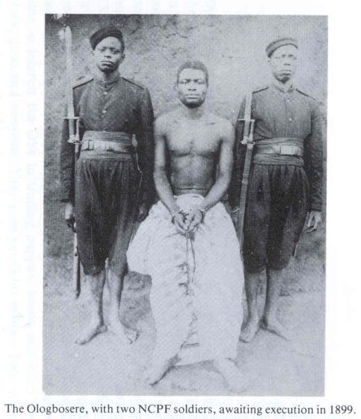
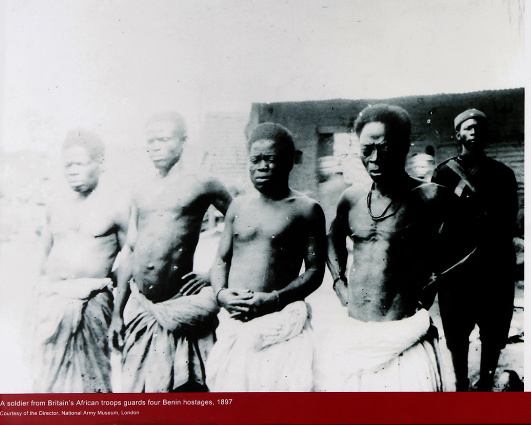
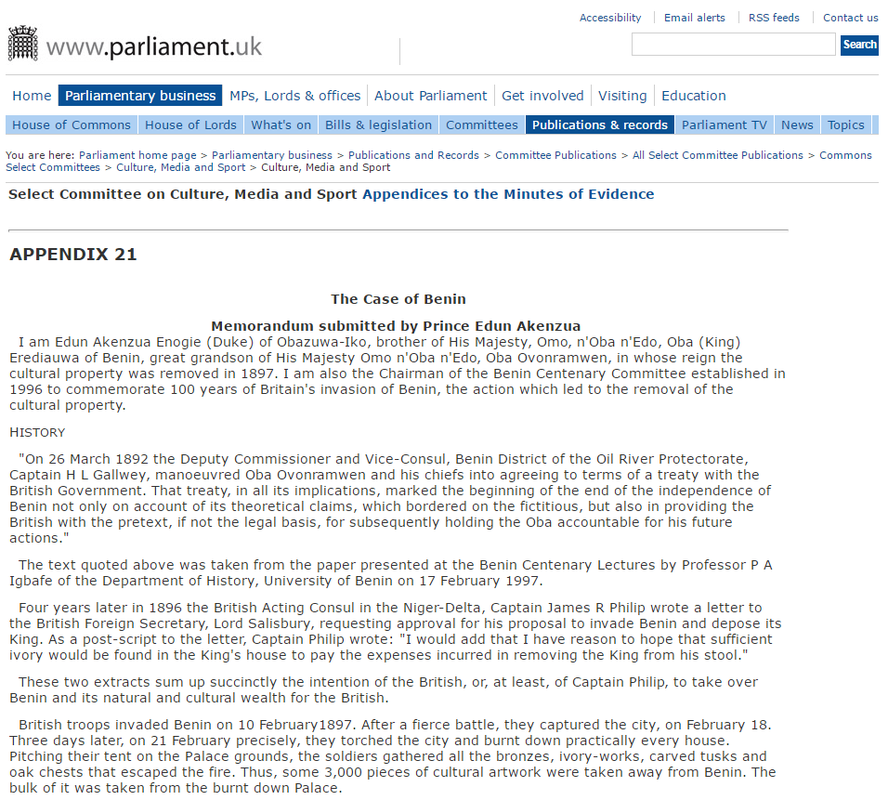
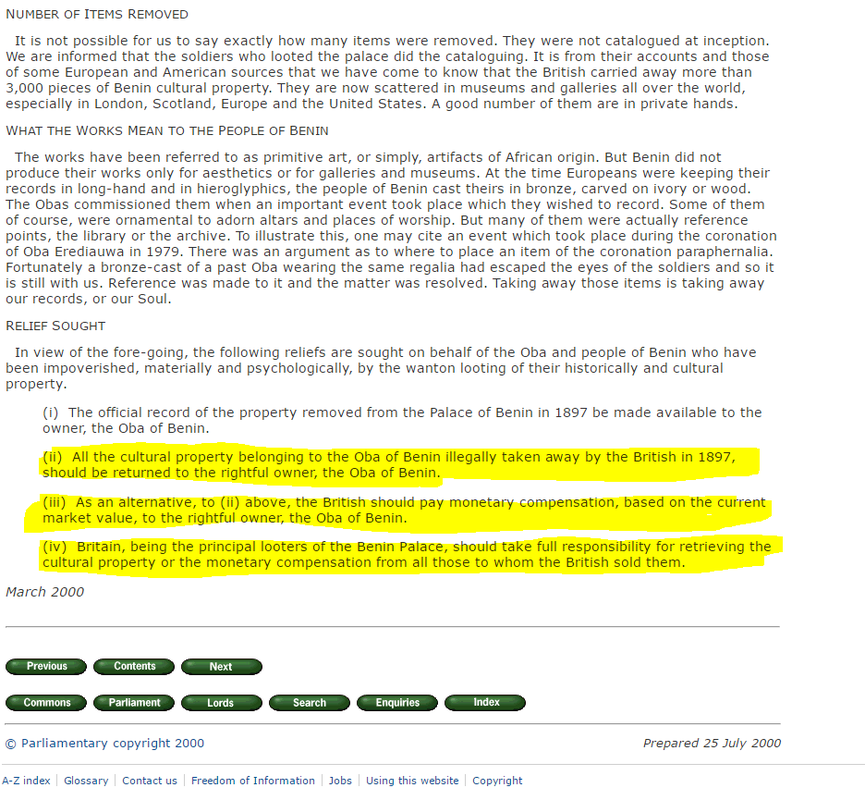
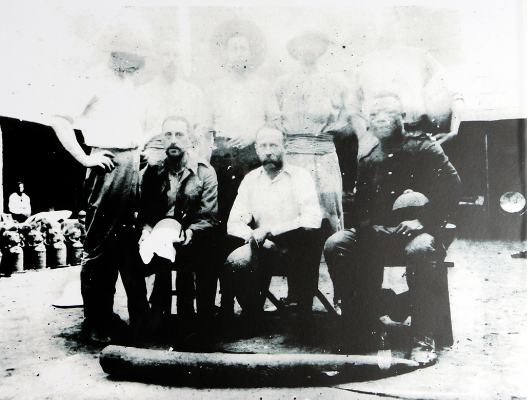

 RSS Feed
RSS Feed

